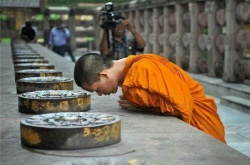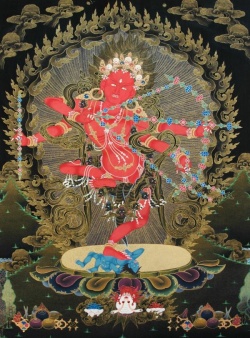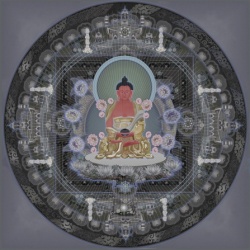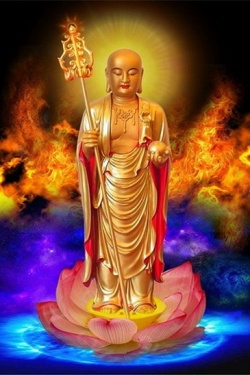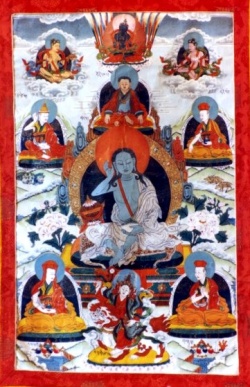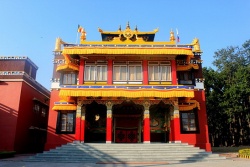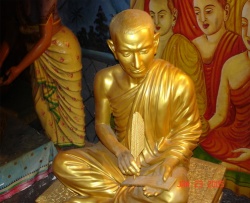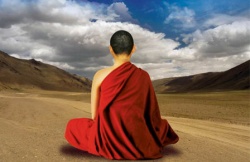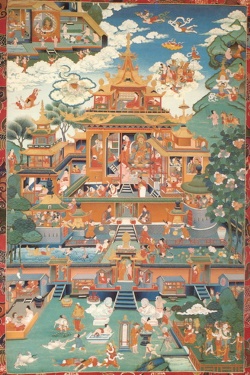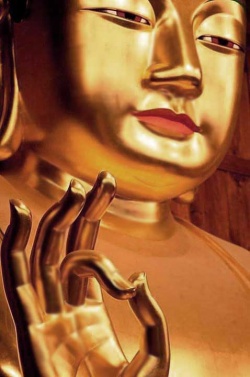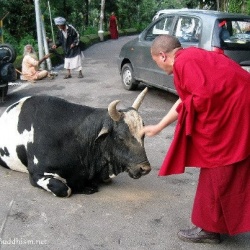Nandamālābhivaṃsa Mahāthera. Fundamental Abhidhamma
Nandamālābhivaṃsa Mahāthera. Fundamental Abhidhamma
1. Why is it called Abhidhamma?
Abhidhamma is unique in Buddhism. It is one of the Tipiṭaka Pāḷi texts which explains dhammas in detail and in an analytical way. Regarding the explanation of dhammas, it does so in more detail than Suttanta. That is why the text is called “Abhidhamma”.
2. Who is the author?
The Buddha is the author of Abhidhamma. There was a controvery about the authorship. It has been said that Abhidhamma is not the teaching of the Buddha. Indeed, that it is only later work. Thera Buddhaghosa, a new commentator, advocates that Abhidhamma is the Buddha’s teaching. It is described in his commentary on Dhammasangaṇī, Atthasālinī by name: “His heart by that world-pitying love inspired,
When, after the Twin Miracle, he dwelt. At the high mansion of the Thirty-three, Throned – like the sun on Mount Yugandhara On Pandukambula, his rocky seat, Under the tree called Paricchattaka, He by that noble insight gave discourse, On the Abhidhamma to the spirit who came, Led by his mother, from the myriad worlds, And compassed him about on every side.” (The Expositor, 2)
3. Who brought Abhidhamma to the human world?
In Theravāda Buddhist circle, it is widely accepted that Abhidhamma was taught to the deity. In the seventh year after His enlightenment, the Buddha went to the world of the deity and taught Abhidhamma for three months.
During those days the Buddha came down to this world for the purpose of having meals every morning as a human. Uttarakuru, the north continent, was the place where the Buddha went for alms-food. After lunch, the Buddha rested under a big tree on the bank of the lake, Anotatta.
Ven. Sāriputta, one of the chief disciples, approached and served the Buddha with water. At this meeting with Ven. Sāriputta, the Buddha briefed him about what He had taught in the deity world. Ven. Sāriputta thus learnt and brought the Abhidhamma to the human world. Then, he taught his Bhikkhu pupils the doctrine. In this way, Abhidhamma was introduced into our world. However, it should be noted that the Abhidhamma taught to the deity is in great detail and that the Abhidhamma retold by Ven. Sāriputta is in a concise form.
4. The seven Abhidhamma texts
The Abhidhamma comprises seven texts, viz.,
(1) Dhammasangaṇī, the Explanation of Dhammas,
(2) Vibhaṅga, the Book of Analysis,
(3) Dhātukathā, the Speech on the Elements,
(4) Puggalapaññatti, the Designation of Individuals,
(5) Kathāvatthu, the Points of Controversy,
(6) Yamaka, the Book of Pairs, and
(7) Paṭṭhāna, the Book of Conditions.
This is the list that is widely accepted in the Theravāda Buddhist circle. There was a controversy about the treatise, Kathāvatthu. Instead of Kathāvatthu the Abhidhamma text was enumerated as “Dhamma hadaya vibhaṅga” by some, as “Mahā dhātu kathā” by others.
Ven. Buddhaghosa advocated the list of the Abhidhamma text only with “Kathāvatthu”. However, Kathāvatthu is a work of Thera Moggaliputta Tissa who made his appearance 263 years after the Buddha’s parinibbāna.
Although it was so, originally the Buddha himself gave “the outline of Kathāvatthu”. Then it was detailed by Ven. Moggaliputta Tissa referring to one thousand suttas – five hundred of His own and five hundred of others. Therefore, as justified by Ven. Buddhaghosa, Kathāvatthu is a teaching of the Buddha in a manner.
5. Commentaries on Abhidhamma
There are five topics that are expounded in the Abhidhamma texts, namely Citta (consciousness), Cetasika (mental concomitants), Rūpa (matter), Nibbāna (a state of freedom from attachment) and Paññatti (concept). Of them the Paññatti alone is unreal (unsubstantive) while the others are real (substantive) in the ultimate sense. They are all denoted by using the term dhamma, which is in the sense of “bearing its own nature”.
The dhammas which are expounded in the Abhidhamma texts are profound. It is difficult to understand them without a complete explanation. Thus commentaries were written to explain the Abhidhamma. It is not known how many commentaries have been compiled. Mahā aṭṭhakathā could be the first commentary. It might be of Indian origin and was brought to Sri Lanka island by Ven. Mahinda who introduced Buddhism into Sri Lanka. Mahā aṭṭhakathā was written in Singhalese in order to avoid mixing of the original meaning with other sect’s views.
Then Ven. Buddhaghosa condensed Mahā aṭṭhakathā and translated it into Pāḷi. Ven. Buddhaghosa’s commentaries are translated into three texts:
(1.) Atthasālinī, the commentary on Dhammasangaṇī,
(2.) Sammohavinodanī, the commentary on Vibhaṅga, and
(3.) Pañca-pakaraṇa aṭṭhakathā, the commentary on the other five texts.
When the new commentaries appeared, the old ones gradually disappeared. As a new commentary became popular and it became necessary to explain it. Ven. Ānanda wrote a sub-commentary on the new commentary. This sub-commentary is known as Mūlaṭīkā. Ven. Ānanda’s Abhidhammic views are very high and his comments are very elucidatory. He criticized some of the views that are expounded by Ven. Buddhaghosa. Then, Anuṭīkā appeared to explain Mūlaṭīkā. It is a work of Ven. Dhammapāla who was also a commentator of Visuddhimagga Mahā Ṭīkā. He was an advocate of the opinion of Ven. Buddhaghosa, which was rejected by Ven. Ānanda.
6. Abhidhamma flourished in Sri Lanka
It is believed that Abhidhamma was introduced into Sri Lanka when Ven. Mahinda, a leader of the Asoka mission, arrived on the island. During the earlier period, the study of Abhidhamma could be through the Pāḷi text and its commentary, Mahā aṭṭhakathā. Before or at the time of Ven. Buddhaghosa, there appeared celebrated Abhidhammic scholars in Sri Lanka. Their names and views are found here and there in the commentaries of Ven. Buddhaghosa.
They are:
(1) Tipiṭaka Cūḷānāga,
(2) Moravāpivāsi Mahādatta,
(3) Tipiṭaka Mahādhammarakkhita,
(4) Tipiṭaka Cūḷābhaya, and
(5) Abhidhammika Godatta.
They are believed to be senior to Ven. Buddhaghosa, the new commentator. Their Abhidhammic views are referenced significantly in his books. Actually Abhidhamma is so profound that it is hard to understand. Students need easy access to that subject.
Therefore, the Abhidhammic scholars in Sri Lanka tried to write concise books on Abhidhamma. Ven. Buddhadatta, a contemporary of Ven. Buddhaghosa, wrote two books: Abhidhammāvatāra (An Approach to Abhidhamma) and Rūpārūpa-vibhāga (The Analysis of Mind and Matter).
In about the ninth century A.D., there appeared an Abhidhammic scholar in Sri Lanka. He is Ven. Anuruddha who came from Southern India to Sri Lanka.
He wrote three books on Abhidhamma:
(1) Abhidhammattha Saṅgaha, Compendium of Abhidhamma,
(2) Paramattha vinicchaya, the Clarification of Reality, and
(3) Nāmarūpa-pariccheda, the Analysis of Mind and Matter.
Through these books the study of Abhidhamma flourished and is kept alive.
7. How Abhidhamma flourished in Myanmar
Perhaps Buddhism could have been introduced into Myanmar earlier than the Asoka mission that arrived in Suvaṇṇa bhūmi, a part of Myanmar. When Buddhism was introduced, the Tipiṭaka Pāḷi texts could have been brought. During the reign of King Manuhā in early 11th century A.D., there were Buddhist monks who were well-versed in Tipiṭaka in Suvaṇṇa bhūmi. When King Anawratha united the entire Myanmar people into one kingdom, Buddhism became more prevalent. The king brought Tipiṭaka books from Suvaṇṇabhūmi as well as from Sri Lanka and established a library to keep them.
The study of Abhidhamma started to become popular in Myanmar. At the time of King Navapati Seethū, 1173 A.D., Ven. Saddhammajotipāla, well known as Sappada (chappada), was back from Sri Lanka after having made a long-term study. He wrote two 13 books on Abhidhamma, Saṅkhepa vaṇṇanā (Concise Explanation) and Nāma cāradīpaka (the Exposition of Mind Appearance). During the reign of King Kyaswā, 1234 A.D. the people of Bagan were interested in Abhidhamma.
The king and other members of the royal families earnestly studied Abhidhamma. The king wrote a small book, Paramattha vindu (A Spot of Reality). Some of the women in Bagan, it was said, even those who had children, learnt a section of Paṭṭhāna by heart.
It was recorded that there was a minister who was well-versed in Tipiṭaka. When the era of Pinya (1312 A.D.) started the study of Abhidhamma continued to be propagated. At the time of King Thiha Thura (1350- 1359) Ven. Ñāṇakitti wrote the two books on Abhidhamma, namely, Atthasālinī-yojanā and Sammohavinodanī yojanā. In “yojanā” book it gives Pāḷi to Pāḷi explanation. When the era of Inwa (726) dawned, the study of Abhidhamma flourished in Myanmar.
The list of Abhidhamma texts that were studied in Inwa are as follows:
(1) The Seven Abhidhamma Pāḷi texts
(2) Commentaries on the above
(3) Mūlaṭīkā
(4) Anuṭīkā
(5) Abhidhammattha Saṅgaha
(6) Ṭīkā on the above [old]
(7) Ṭīkā on the above [new]
(8) Nāmarūpa-pariccheda Ṭīkā [new]
(9) Paramattha-vinicchaya Ṭīkā [new]
(10) Mohāvicchedani
During the reign of King Narapati (1442-1468) of Inwa, Thera Ariya vaṃsa wrote in Pāḷi a commentary on Vibhāvinī. It is named “Manisāramañjūsā”. In Ramañña Territory, lower Myanmar, the King Sinphyushin ruled Haṃsavati (Hantharwady as the Burmese pronounced). During that time (1550-1580) Thera Mahāsuvaṇṇadīpa wrote in Pāḷi Apheggusara-dīpanī, a commentary on Vibhāvinī.
Also, there have been many books, Nissaya, in which word for word translation into Burmese is offered. During the reign of King Thalun (1629-1648), the Pathamapyan examinations were held. In this examination Abhidhamma was a compulsory subject. Therefore, the study of Abhidhamma was prevalent among Buddhist monks.
A large number of books on Abhidhamma either in Pāḷi or in Burmese appeared in this period. During the Konbaung period 1753-1885), the study of Abhidhamma continued to be popular. In monastic examinations, Abhidhamma was a compulsory subject.
At present, even lay people are interested in Abhidhamma. Abhidhamma examinations are held yearly for lay people. Mandalay, a great Buddhist study centre, was founded in 1859 by King Mindon. During the reign of King Mindon (1859-1878), there were 60,000 monk students who were studying Pāḷi and Tipiṭaka under 80 great monk teachers in Mandalay.
The king honoured the teachers with the highest title, Rājagūru, and awarded provisions for food, cloths, shelter and medical treatment. In those days, monks delivered lectures on Abhidhamma using two reference books, Mūlaṭīkā and Anuṭīkā.
No reference was made to the two books, Vibhāvinī and Manisaramañjūsā. Their opinion was that Vibhāvinī was full of mistakes and Manisaramañjūsā was full of unnecessary points. In Myanmar there are a large number of Abhidhamma texts that are edited and printed. There are seven Abhidhamma treatises which are of Indian origin. The commentaries and sub-commentaries which were written in Sri Lanka, number 26.
In reference to those Pāḷi and Commentaries, Abhidhammic scholars in Myanmar wrote numerous books that dealt with Abhidhamma. Those which are written in Pāḷi number 43, those written in Pāḷi and Burmese number 112, and those that give general information on Abhidhamma amount to 333 books, according to the list of “Abhidhamma History” in Burmese (printed in 1965). Thus, in Myanmar, the study of Abhidhamma is still kept alive.
8. The role of Abhidhammattha saṅgaha
In Myanmar Abhidhammattha saṅgaha is widely known as “Thingyo” which is derived from the Pāḷi word “saṅgaha”, or “thingaha” as Burmese people pronounce. In monastic schools in Myanmar the two books, “Thada” and “Thingyo” are very important subjects. They are compulsory in Pāḷi examinations and young novices are required to learn them by heart. Here “thada” which is derived from “sadda” is denoted “kaccayāna”, the Pāli Grammar.
Thingyo or Abhidhamma saṅgaha serves as a primer of Abhidhamma in Myanmar. Its utility ranks very high, and its excessively condensed points stimulates students who wish to learn Abhidhamma with greater efforts. The way in which Burmese Abhidhamma students practice is as follows: First they learn “Thingyo” by heart, then the meaning through the “Nissaya” books in which word for word translation is given. After that students need to study the text by going into detail through commentaries, such as Vibhāvinī Ṭīkā. This is the way of learning the text at the ordinary level. At the advanced level, students need to proceed with the study of Abhidhamma through the original Pāḷi texts and their commentaries.
In this way, Burmese Buddhist monks are well-versed in Abhidhamma. So Abhidhammattha saṅgaha plays a key role in study of Abhidhamma. To learn Abhidhammattha saṅgaha there needs to be commentaries in which general information are given. The following are some of Commentaries on Abhidhammattha saṅgaha:
Abhidhammattha saṅgaha Ṭīkā [old], by Nava vimalabuddhi of Sri Lanka,
Abhidhammattha Vibhāvinī, by Sumaṅgala sāmi of Sri Lanka,
Sankhepa vaṇṇanā, by Saddhamma-jotipāla of Myanmar [1446],
Abhidhammattha dīpanī, by Silācāra of Myanmar [1801],
Paramatthadīpanī, by Ñāṇa Thera, Ledi Sayadaw, of Myanmar [1897], 6. Aṅkura Ṭīkā, by Vimala Thera of Myanmar [1905],
Mahā atula Ṭīkā, by Nāgindasāmi of Myanmar [1914],
Abidhammattha saṅgaha vinicchaya, by Paññājota of Myanmar [1919].
9. The role of ]]Vibhavāni\\ 17 10. Ledi Sayadaw
Vibhāvinī, as its full name ]]Abhidhammattha Vibhāvinī\\, is one of the commentaries on ]]Abhidhammattha saṅgaha]]. It is a work of Sumaṅgala sāmi and the most popular and most authoritative. The writing style is very simple and the explanations are elucidatory. So the Commentary is known in Myanmar as “Ṭīkā-gyaw” meaning “the famous Ṭīkā”.
In Myanmar Buddhist monks have been studying Ṭīkā-gyaw since long time ago. It demands the easy access to the text and commentaries were compiled in Pāḷi or in Burmese by scholar monks. During the Konbaung period (1753-1885) there have been some Abhidhammic scholars whom criticize Vibhāvinī. They asserted that Vibhāvinī is full of mistakes. Although it is so, Vibhāvinī continues to maintain its populatity among those who study Abhidhamma in Myanmar.
10. Ledi Sayadaw
The history of Abhidhamma would not be complete without mentioning Ledi Sayadaw, a great teacher of Abhidhamma, and one of his famous writings, Paramatthadīpanī, the most important book in the history of Abhidhamma. He was born in 1846 in a village, Saipyin, in Dipeyin Topwnship, upper Myanmar. The name given him by his preceptor was Ñāṇa.
After he had entered into the order, he studied Pāḷi and Tipiṭaka in Mandalay. In 1886, he founded a monastery in the forest, Ledi, in the north of Monywa. It was named “Ledi” after the forest. Ven. Ñāṇa was known “Ledi Sayadaw” after the name of the monastery he founded. Ledi Sayadaw wrote over 100 books on grammar, ethical, religious and philosophical aspects of Buddhism. Of them Paramatthadīpanī is a book which is written in Pāḷi and, as mentioned before, it is the most important in the history of Abhidhamma.
His fame spread beyond the borders of Myanmar. In 1911 the Government honoured him with the title of “Aggamahā paṇḍita”. In 1918 an honorary degree, D.Lit., was conferred on him by the University of Rangoon. Ledi Sayadaw passed away in Pyinmanar at the age of 77.
11. Paramatthadīpanī, the critic of Vibhavāni
Ledi Sayadw was very interested in Abhidhamma, and had been studying that doctrine with great attention. He noticed that some opinions were mistakenly informed in Abhidhamma commentaries. Especially Vibhāvinī is full of grammatical, logical and philosophical mistakes.
In 1897 Ledi Sayadaw wrote Paramatthadīpanī, a commentary on Abhidhammattha saṅgaha. It offers general information of the text and correct meaning of the words. It also pointed out some mistakes which are put forward in Abhidhamma commentaries, especially in Vibhāvinī. Paramatthadīpanī made several unfavourable comments about the opinion of Vibhāvinī and presented innovative ideas.
However, the innovations presented in Paramatthadīpanī had not met with general acceptance. Actually the critique aroused more controversy among the readers. The advocates of Vibhāvinī published some commentaries which were written in Pāḷi:
1. Aṅkura Ṭīkā, by Ven. Vimala, Talaigon Sayadaw, in 1905,
Mahā atula Ṭīkā, by Ven. Nāgindasāmi, in 1914,
Paramattha visodhanī, by Ven. Dīpamāla, Chaung Oo Sayadaw,
Abhidhammattha Vibhāvinīyojanā, by Ven. Ñāṇindāsabha, in 1918, and
Abhidhammattha-saṅgaha vinicchaya, by Ven. Paññājota, in 1919.
There were also other books and articles written in Burmese, some offering unfavourable comments and others giving favourable comments about the criticizing Vibhāvinī. But “Abhidhammattha saṅgaha vinicchaya” arbitrates between the two commentaries, Vibhāvinī and Paramatthadīpanī. In 1916, Ledi Sayadaw wrote Anudīpanī, a sub-commentary on Paramatthadīpanī, to clarify his innovation in Paramatthadīpanī.
Ven. Ashin Nandamālabhivaṃsa Mahā Subodhayon Kyaung Taik Sagaing Hill, Sagaing, Myanmar June 1997
1. Abhidhamma – Definition
Namo sammāsambuddhassa
Abhidhamma: Abhidhamma, the Pāḷi term, is used for the profound dhamma. The text in which the profound dhamma is explained is also called “Abhidhamma”. The commentary gives the definition of “Abhidhamma” thus: Abhidhamma is a treatise in which the dhamma is explained in more detail and in an analytical way than Suttanta.
2. Seven Abhidhamma Texts
There are seven treatises that compose the whole “Abhidhamma piṭaka”, meaning “the basket of philosophy”.
They are comprised as follows:
1. Dhammasangaṇī Classification of Dhammas
2. Vibhaṅga The Book of Analysis
3. Dhātukathā A Talk on the Elements
4. Puggala paññatti Designation of Individuals
5. Kathāvatthu Points of Controversy
6. Yamaka The Book of Pairs
7. Paṭṭhāna Conditional Relation
3. The two types of Dhammas that are explained in Abhidhamma
There are two types of dhammas that are explained in Abhidhamma treatise. They are Paññatti and Paramattha.
Paññatti comprises names and things. The names are paññatti. Because, through names we are able to know things. Things are also paññatti. Because they have to be known through names. All of the names we call and all of the words we use are “sadda paññatti”. Because, through them we have to know the things concerned. The things are “attha paññatti”. Because they have to be known by mean of names and words.
Paññatti changes its designation when its form or substance changes. It is, however, conventional truth (sammuti sacca), because it is something that is generally accepted. Using the conventional truth, the Buddha gives guidelines dealing with status, obligation of human society, morality, conditions of success in life and so on.
Paramattha is the ultimate reality. The dhamma of ultimate reality is that they never change (their nature or characteristic). It is real forever. The ultimate reality is abstract truth (paramattha sacca). Using the abstract truth, the Buddha expounds the wisdom of realization and emancipation (liberation).
4. The four Ultimate Realities
The ultimate reality can be divided into four according to its own characteristics, namely:
1. Citta Consciousness
2. Cetasika Mental states
3. Rūpa Matter
4. Nibbāna
The state of freedom from attachment In the ultimate sense, a human being is only a concept. It is composed of mind and matter. Mind consists of consciousness and mental states. Nibbāna is a state in which mind and matter become completely extinct.

